Frozen Waterfalls and Fallen Glaciers
Frozen Waterfalls and Fallen Glaciers
Everest Base Camp the Lazy Way Day 8 – Dole to Machermo
Heading out of Dole up to Macchermo, the landscape shifts ever onwards from late autumn towards winter.
We’ve crossed frozen rivers and waterfalls, some with streams still bubbling below them as the sun warms them into life, webs of twigs and branches still embedded in their fossil flow, mysterious crystallisations in the ice, their surface lumped and bumped as if – and how is this possible? – the cold caught the waves in the act.
And slowly the trees begin to fade, the rhododendrons vanish. The junipers now are tiny, scrabbling, scrunched up things, warped and scrawny shrubs with knotted roots clinging flat for dear life against the wind.
There are still yaks grazing in the high pastures, shaggy, heavy-humped, bad-tempered creatures, though it’s hard to see from the sere yellow fuzz that clings to the dusty earth what there is for them to feed on.
Below us, the Dudh Koshi roars away. Ahead of us, high, high mountains are looming in the distance, white capped, dramatic: Cho Oyu! An 8000m peak.
And yet… we started walking once the sun was up and shining, and in our hats and fleeces with the warm sun in our faces, it’s really very lovely.
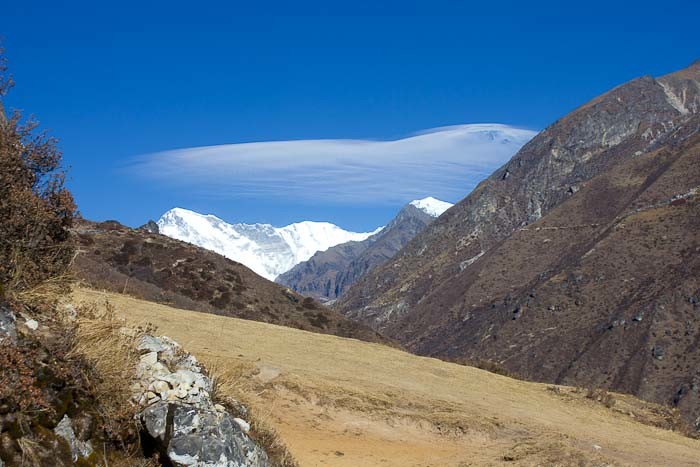
It’s a short walk, Dole to Machermo, a fairly steady and leisurely undulation up the valley. Under two hours if you’re fast, over three if you’re ambling and stopping and lazing in the sun and drinking hot lemon in tea houses and taking photos, but, like a lot of days on this trek it’s…. short.
One reason, in fact, why I undertook the Everest Base Camp trek and Zac agreed to do it is for these short, easy days. You can’t rise too high too fast, so a lot of the time you aren’t really going far.
Which is probably a downer if you’re a serious, hardcore, fast-paced hiker, and it’s these hyper-fit, driven people that the rescue helicopters come and go for, because they climb too high, too fast.
But for people like us who like to wander along gawping at stuff and taking in the views, it’s wonderful.
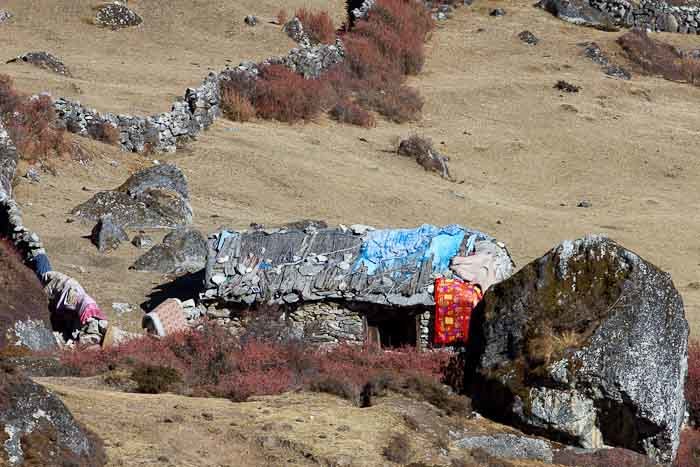
Machermo is our destination, where we’ll spend two days. It’s a kilometre above Namche, at 4470m (14,670 feet), and because Zac’s only twelve, and only just twelve at that, I’m being dutiful about acclimatisation.
Even though neither of us has had so much as a headache yet, this is the highest either of us has ever been, and we’ve got almost a kilometre to go.
There isn’t a lot to Machermo itself. At this altitude, we’re past the heights where anyone lives full-time: it’s a yak herding station in a sunny valley with a stream that freezes at night and races in the day, and a cluster of six or so bright-roofed trekking lodges, all with the so-familiar menu, overshadowed by an impressive black canyon with the slurried remains of what was once a glacier.
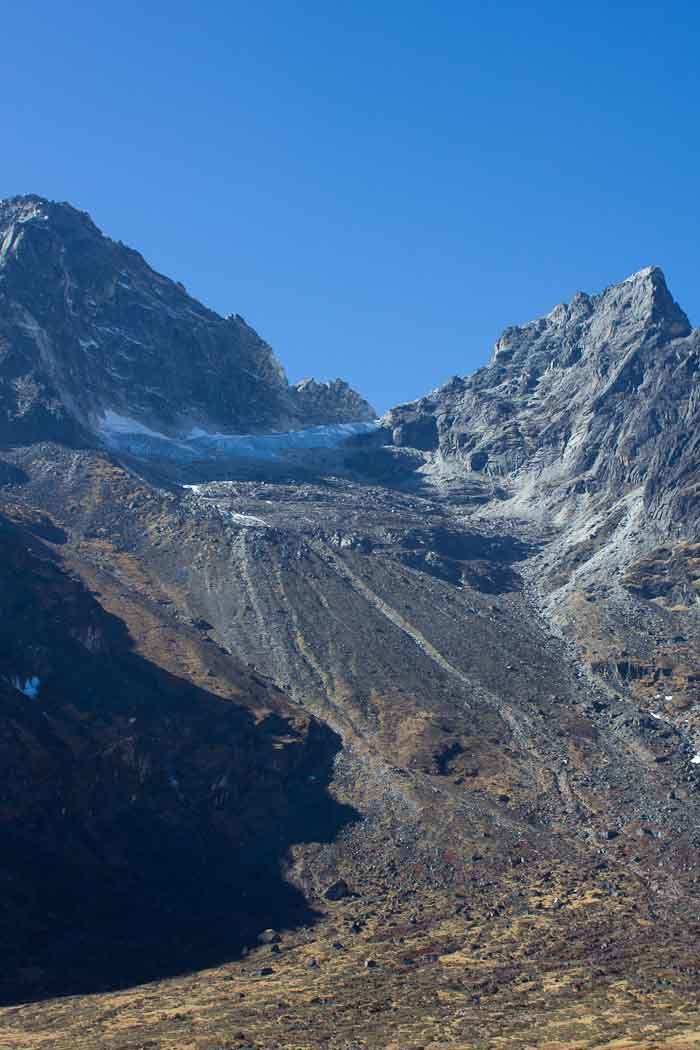
One thing Machermo does have? A natural laundry!
We embarked on the Everest Base Camp trek in the full knowledge that we would smell and be filthy. That’s just how it is.
It would be ludicrous to even attempt to carry enough clothes to keep you clean, at higher altitudes it’s really too cold to wash or even strip down to change, and only the one communal area of the lodges has any heat at all, that from a brazier which boils kettles constantly.
The laundry goes like this. Black rubber hosepipes run down from the higher reaches of the stream, feeding the village clear water. When the sun goes down over the pipes, they freeze. When the sun shines on them, it warms the water to a temperature that feels as tolerably cool as tropical mid-ocean.
I take my bowl, squat on my heels, and scrub away at some very crunchy socks, taking turns with the guys filling jerry cans with water for the lodges, and the porters scrubbing their clothes, I avert my eyes as the guys wash their hair and torsos in the sun.
A shadow begins to descend on the valley. All of a sudden, my hands are red and cold.
“Finish tomorrow,” Nir says.
I realise, with a gulp, that with my Western resource-hogging ways I’ve taken bowl after bowl of water that could be used for cooking, for washing, for drinking, for the bathrooms, because I don’t know how to rinse my clothes without wasting water.
I weight our stuff into the drystone wall with rocks and leave it to freeze, melt and then sun-dry, as the yaks lollop, ludicrously, down from the hills above, and Zac concludes a final skate on the frozen stream.
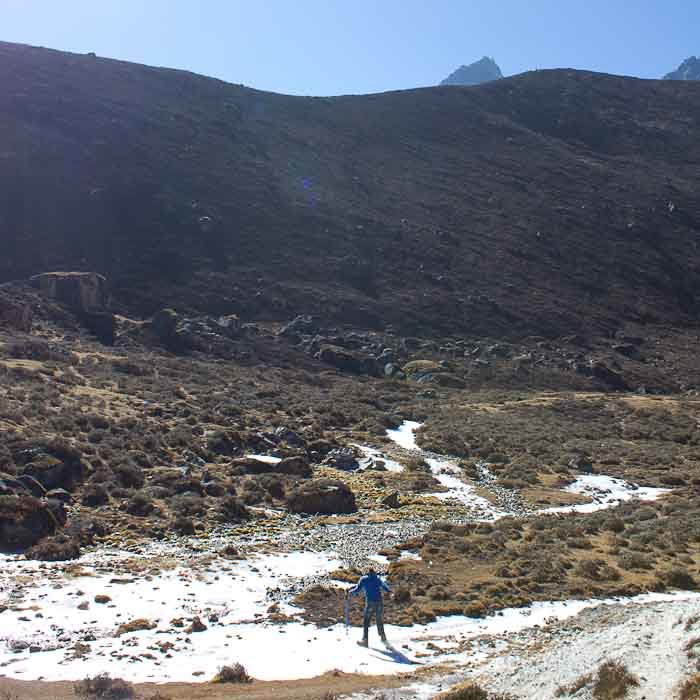
Tomorrow is a rest day, but I figure we should climb a bit, not least because the last couple of days walking have hardly been taxing.
My admittedly limited understanding of acclimatisation to altitude is that it’s good to spend a rest day climbing significantly higher than you will sleep. I’d also like, if possible, to climb something relatively steep.
We are not far, now, from the Cho-La Pass, the glacier crossing at 5330m (17,500 feet) that begins with an ascent of 400 vertical metres (1300 feet) which Nir describes as “very up”. It is not always possible to cross, and sometimes you need ropes and crampons.
Some people have found the pass beautiful, dazzling, awe-inspiring. Others have turned around. One guy reported that “We managed it but all the girls were crying”. Everyone seems unanimous that it’s difficult.
And most cast very beady eyes over Zac, whose 32kg (70 lb) sit lightly on his five foot frame, and who seems to be taking a personal pride in wearing even fewer layers than the Sherpas.
I don’t mention in these conversations that I’m scared of heights.
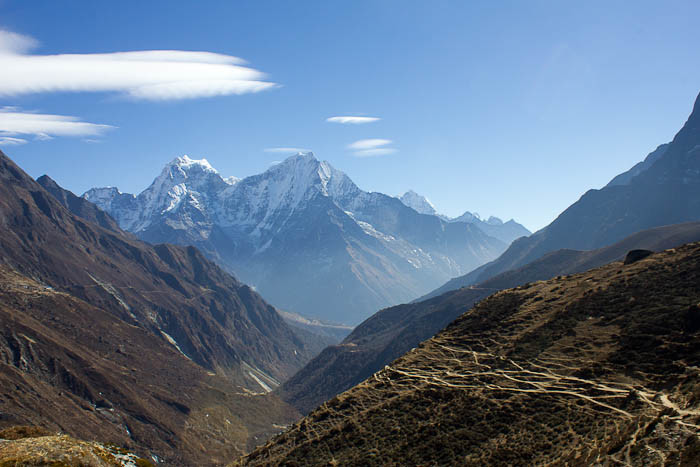
Anywise, we need to be over the pass early in the day for safety reasons, which means we need to do 400 vertical metres fast, and, although we’ve done one long, tough jungle trek to find hunter-gatherers, climbed high on Mount Kinabalu and done a little bit of valley walking in Tiger Leaping Gorge, we are neither of us particularly fit.
The peak next door to us, a little black-topped thing with a grassy hill festooned with prayer flags looks like our best bet for acclimatising.
It’s only 300m high, the chap at the lodge thinks, though he’s not climbed it, and nor has Nir, nor any of the guides.
That’ll be the perfect way to spend the morning, I think.
Nothing too strenuous. Nothing difficult at all. Just 300m up, not even a thousand feet, past that little band of black rock and onto the black above. There’s a snow peak up there somewhere but that’s not climbable without gear, but the black summit is easy enough to reach.
Sounds perfectly doable, I figure. Easy as.
Machermo Ri, we have your number…
Use the “Previous” and “Next” post buttons below to navigate through this site. Or you can start from Day 1 of our Everest Base Camp trek, read the last post in my Everest Base Camp series or the next post here.
If you’re thinking of doing the Everest Base Camp trek, I recommend my Everest Base Camp FAQs.

Cool photos, I know it’s kinda silly to ask but, is it really that hard to climb a frozen mountain than a tropical one?
The difficulties with snow and ice are that it’s often harder to get a proper grip, also that at altitude your body finds it harder to generate the heat to keep you warm. Most high mountains are capped with snow, in any case, but the difficulty of a climb largely depends on how steep the mountain is and what ways up it there are.
I’m the same Elaine who inquired about your camera at the end of the Cho La post; now reading in chronology as I prepare for our own journey and soaking up such wonderful tidbits of information such as: “It would be ludicrous to even attempt to carry enough clothes to keep you clean, at higher altitudes it’s really too cold to wash or even strip down to change. . .” *Note to self, pack light and bring a collapsible bucket.
Also, (a few posts back) nice pics of the outhouses with um, views. . .hurrah, can’t wait for that. I can smell it already! 🙂
Or, who can forget your lovely description of the much-anticipated flight to Lukla? (I shared it with one friend who classified it as TMI).
Still reading and dreaming, many thanks to you. ~Elaine
Ah! A pleasure. So glad you’re enjoying…